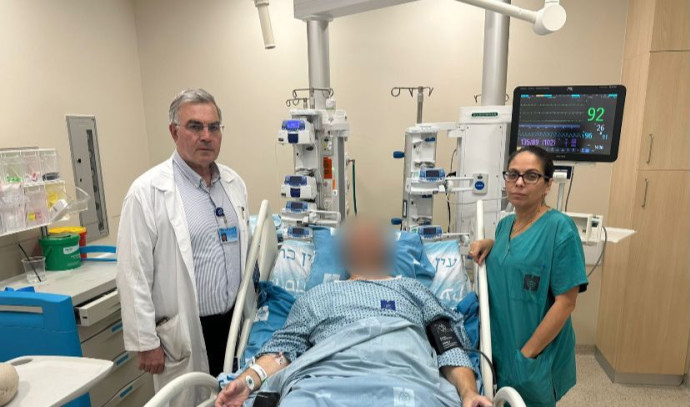Air passengers on long flights – especially pregnant women or people with chronic diseases – are advised to move around to avoid suffering from a pulmonary embolism (PE), which is usually caused by the breaking off of a blood clot in your leg’s deep veins, known as deep vein thrombosis (DVT).
Now, cardiologists at Hadassah University Medical Center in Jerusalem’s Ein Kerem have reported the first documented case of a patient, F., who suffered a PE by sitting for hours in a safe room – in Sderot during constant missile attacks by Hamas terrorists.
Prof. Eyal Herzog, head of the hospital’s cardiology department at Hadassah Ein Kerem, said: “The phenomenon is identical to that described in the medical literature regarding people who fly on long flights. Even in the safe room, it is important to get up and move around as much as possible.”
F. arrived at the hospital in a life-threatening condition after sitting in a safe room for a long time. Aged 52, he was flown by helicopter to the hospital in critical and unstable condition due to a large PE that caused severe damage to the right ventricle in his heart. A pulmonary embolism starts as a blood clot in the leg and moves on to the lungs.
The condition is is one of the most-common cardiovascular diseases in the world and ranks third behind a heart attack and stroke, striking about 350,000 people annually in the US alone – Those who are at high risk include smokers; the overweight; women who take birth-control pills or hormone-replacement therapy; people who are inactive for long periods while traveling in trains, on cross-country car rides as well as planes; recently suffered trauma to a vein, possibly after recent surgery, or varicose veins, have a history of heart failure or stroke; or received a central venous catheter through the arm or leg.
As a PE is most often a consequence of DVT, the first signs are shortness of breath and chest pains that get worse if when exerting oneself or taking a deep breath. Others are unexplained sharp pain in the chest, arm, shoulder, neck or jaw, and the pain may also be similar to symptoms of a heart attack. You may even cough up bloody mucus If you have these symptoms, get medical attention right away. Cough with or without bloody mucus.
Dr. Gabby Elbaz, a physician in Hadassah’s cardiology department who is also and a senior catheterist, added: “This case certainly makes it clear how this dangerous situation can continue, as we have seen, for several days in a row. This is a significant warning light for thousands in the State of Israel who are forced to stay in the safe room for a long time, usually in a small structure with other family members, so walking inside it is almost impossible, and yet, we recommend that during prolonged sitting in the safe room, one should maintain mobility, specifically to keep moving.”
Constant sirens caused prolonged stays in safe rooms
With the beginning of Operation Swords of Iron and the constant sirens in Sderot not far from Gaza, F. entered the safe room in his home with his family. He noted that his stay in the safe room was significantly extended, and he sat motionless for hours. “The barrages were heavy and continuous that there was no point in going in and out of the protected area, so I just stayed sitting in the safe room for long hours.
“I am a healthy person with no background of chronic diseases, and towards evening, I began to feel difficulty breathing. At first, I didn’t attach much importance to it; I didn’t think it was serious or life-threatening.” F. and his family waited for the security situation to calm down a little, and they decided, like many residents of the south, to evacuate to Eilat.
After a few days, during which he did not feel well and his health did not improve, he decided to go to the hospital, where they found that he was suffering from a PE. Arriving at Hadassah in critical condition, he was treated by the special invasive team that treats PEs. Elbaz and Dr. Mordechai Golomb, who catheterized F., recalled that “as soon as the helicopter landed at Hadassah, we understood that he was in critical and life-threatening condition. After clinical evaluation per the medical protocols for these cases developed at Hadassah, we performed cardiac catheterization, injecting a drug through a catheter directly into the pulmonary artery in the heart that dissolved the blood clot. The treatment was very successful with immediate improvement in the patient’s clinical condition.”
Herzog concluded that in very-tense times such as these, when many civilians spend many hours in protected areas, it is important for us to emphasize the critical significance of moving around in the safe room. If, after sitting there for a long time, sensations of sudden shortness of breath, chest pain, or a feeling of fainting appear, seek medical attention immediately. This is literally about saving lives.”




